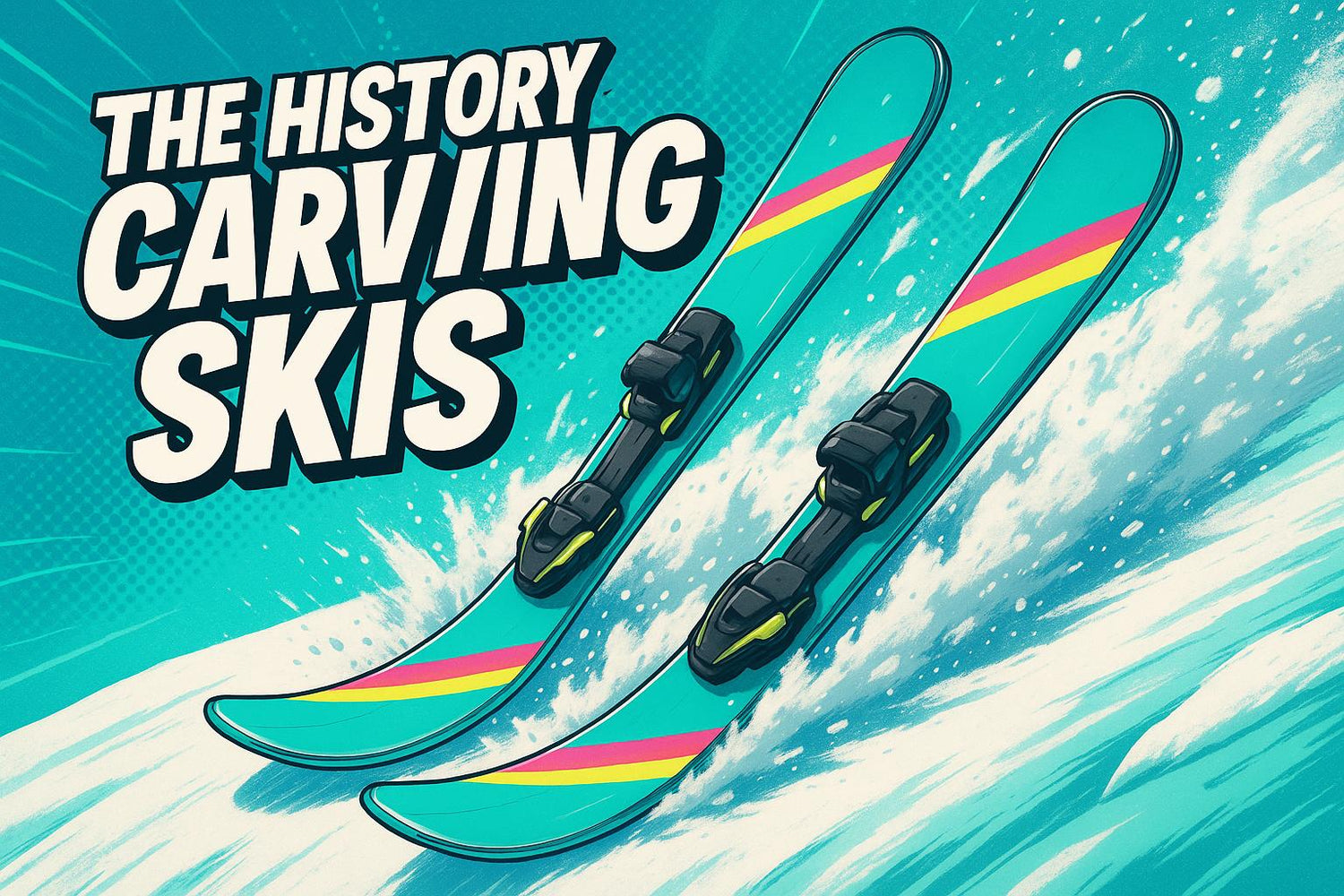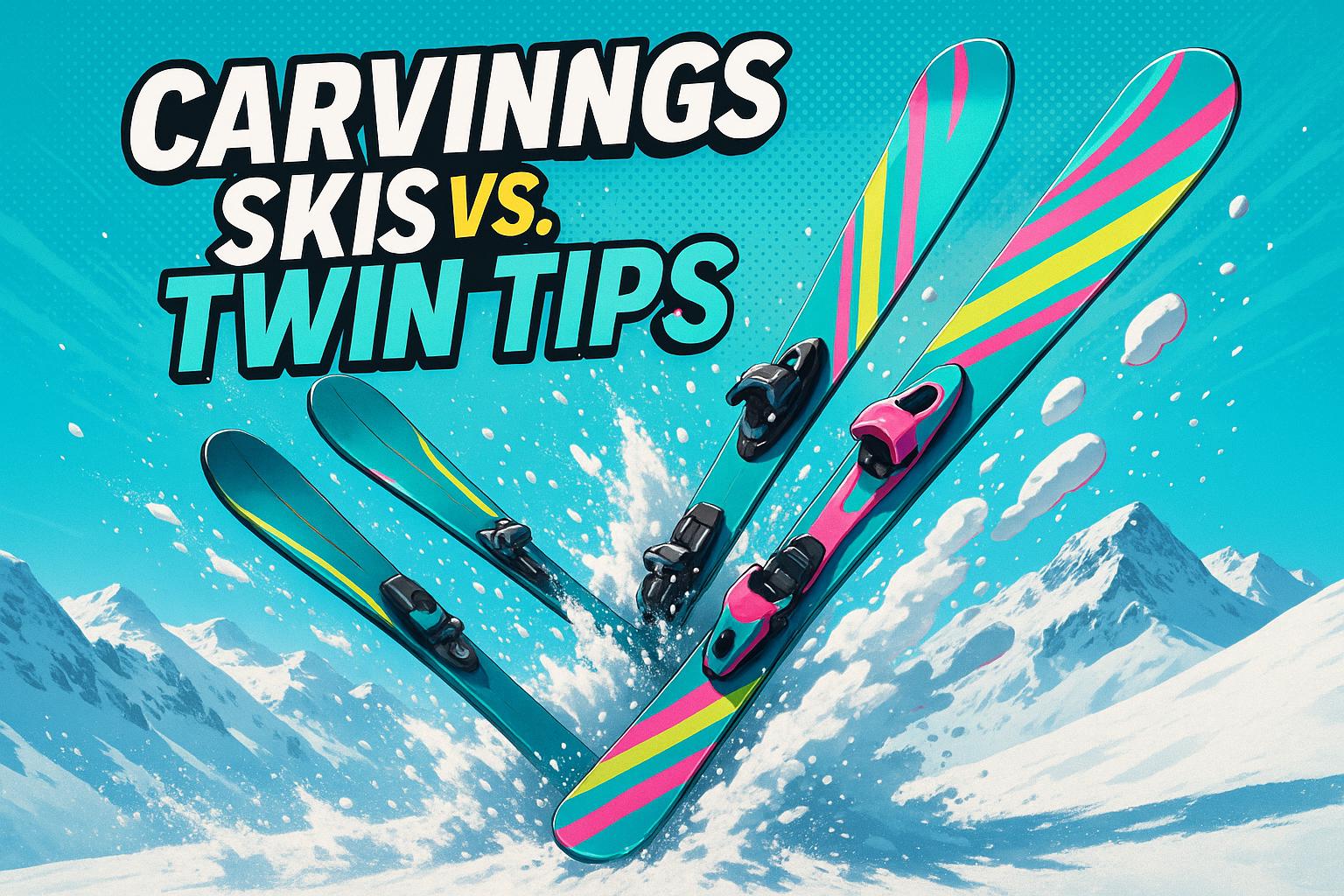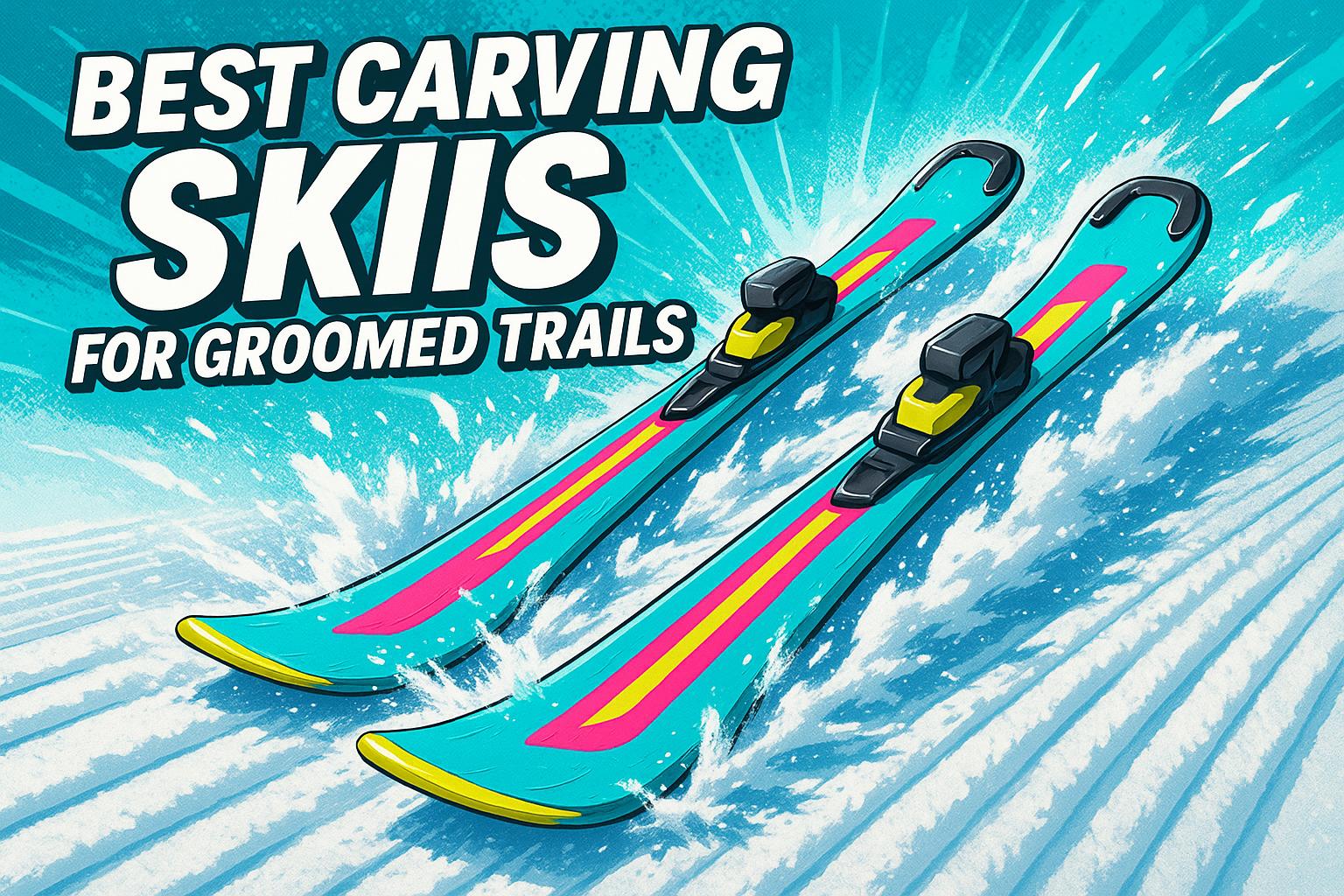Carving-Ski haben das Skifahren in den 1990er Jahren komplett verändert. Vor ihrem Aufkommen war Skifahren anstrengend – lange Ski und rutschige Kurven machten den Sport ermüdend. Dann kamen Carving-Ski mit ihrem Sanduhr-Design (Sidecut), die sanfte, kontrollierte Kurven ermöglichten. Das war nicht nur eine kleine Änderung – es machte das Skifahren für alle einfacher, schneller und spaßiger, von Anfängern bis zu Profis.
Das hat sich geändert:
- Leichtere Kurven: Das Sidecut-Design ermöglichte es Skifahrern, Bögen zu schneiden statt zu rutschen, was das Skifahren weniger anstrengend und präziser machte.
- Zugänglicher: Anfänger lernten schneller, und der Sport wurde weniger einschüchternd.
- Beliebtheitsboom: Bis 2005 nutzten 80 % der Skifahrer in Ländern wie Deutschland Carving-Skier.
Spulen wir vor bis heute, und Short Skis wie die von Snowfeet*, treiben die Evolution weiter voran. Kompakt, leicht und mit normalen Winterstiefeln nutzbar, öffnen sie das Skifahren für noch mehr Menschen. Es ist der nächste große Schritt, um Schneesportarten einfach und spaßig zu machen.
Willst du die Details? Dann tauchen wir ein.
Evolution der Skier
Woher Carving-Skier stammen
Carving-Skier haben einen langen Weg zurückgelegt, von uraltem Überlebensgerät zu den schlanken, präzisen Werkzeugen, die wir heute kennen. Ihre Geschichte ist eine faszinierende Reise, geprägt von Notwendigkeit, Kultur und Innovation.
Wie das Skifahren begann
Skifahren ist kein modernes Hobby – es ist uralt. Die ältesten Skier, die auf 8.000–7.000 v. Chr. datiert werden, wurden in Russland und Skandinavien gefunden. Diese dienten nicht dem Spaß; sie waren Überlebenswerkzeuge, die Menschen halfen, verschneite Landschaften für Jagd, Transport und sogar Verteidigung zu durchqueren.
Die Samen Skandinaviens gehörten zu den ersten, die das Potenzial des Skifahrens wirklich erkannten. Unterdessen entdeckten Archäologen in Nordchina 8.000 Jahre alte Skier aus langen Holzplanken, die mit Pferdehaar bedeckt waren. Und in Norwegen zeigt eine 4.000 Jahre alte Felsgravur nahe dem Polarkreis, wie tief das Skifahren in frühen Kulturen verwurzelt war.
Roland Huntford, Autor von Two Planks and a Passion: A Dramatic History of Skiing, fasste es perfekt zusammen:
"Skifahren ist kein modernes Konzept... Höhlenzeichnungen in Zentralasien deuten darauf hin, dass der Mensch während der letzten Eiszeit Skier benutzte."
Damals waren Skier einfache Holzplanken – nichts Besonderes, einfach funktional. Sie dienten dazu, harte Winter zu überstehen und am Leben zu bleiben.
Telemark-Stil und gebogenes Skidesign
Spulen wir zurück ins 19. Jahrhundert nach Norwegen, wo das Skifahren sich von purem Überleben zu etwas Anspruchsvollerem entwickelte. Hier tritt Sondre Norheim auf den Plan, oft als Vater des modernen Skifahrens bezeichnet. Im 1800er-Jahren führte er die Telemark-Technik ein, die es Skifahrern erlaubte, die Fersen anzuheben, was ihnen mehr Freiheit und Kontrolle gab. Das war nicht nur eine praktische Verbesserung – es brachte Anmut und Balance in den Sport und legte den Grundstein für das moderne Skifahren.
Norheims Fähigkeiten zeigten sich eindrucksvoll 1868, als er mit seiner "Engel"-Technik einen beeindruckenden Sprung von 108 Fuß (etwa 33 Meter) machte. Seine Leistung zeigte, dass Skifahren mehr als nur funktional sein kann – es kann schön sein. Diese Hinwendung zu dynamischer Bewegung brachte Skimacher dazu, mit geschwungenen Designs und besseren Bindungen zu experimentieren und ebnete den Weg für die Weiterentwicklung des Sports.
Sidecut-Design: Die erste große Veränderung
Einer der größten Sprünge im Skidesign kam mit der Einführung des Sidecuts. Wenn du jemals einen Ski von oben betrachtet hast, ist dir seine Sanduhrform aufgefallen – breiter an Spitze und Ende, schmaler in der Mitte. Das ist der Sidecut, und er ist ein echter Game-Changer.
Obwohl eine Form des Sidecuts bereits 1808 existierte, waren die Kurven flach – nur 4 bis 5 Millimeter. Bis 1939 übernahmen Slalom-Skier einen etwas tieferen Sidecut von 7 Millimetern als neuen Standard. Als Designer 1948–49 einen dramatischen 15-Millimeter-Sidecut versuchten, wurde dieser als zu extrem angesehen und schnell verworfen.
Der wirkliche Durchbruch kam 1993 mit dem Elan SCX. Dieser Ski hatte einen deutlich ausgeprägteren Sidecut, der das einläutete, was wir heute parabolische oder shaped Skier nennen. Interessanterweise hatten Snowboards schon seit Jahren tiefere Sidecuts verwendet. Inspiriert vom Snowboard-Design verfeinerten Skimacher ihren Ansatz und schufen Skier, die den Schnee greifen und saubere Bögen schneiden konnten. Das war ein großer Bruch mit der alten Rutsch- und Gleittechnik und bereitete den Weg für die Carving-Revolution der 1990er Jahre.
Dank dieser Innovationen wurde das Skifahren zu dem aufregenden, präzisen Sport, den wir heute kennen. Die Reise von den antiken Holzlatten zu High-Tech-Carving-Skiern ist ein Beweis für menschlichen Einfallsreichtum und unseren Drang, Grenzen zu überschreiten.
Wesentliche technische Verbesserungen bei Carving-Skiern
Im Laufe der Jahre haben Carving-Skier eine bemerkenswerte Transformation durchlaufen. Fortschritte in Materialien, Design und Sicherheit haben einfache Holzlatten in Hochleistungswerkzeuge verwandelt, die nicht nur die Leistung der Skier, sondern auch das Erlebnis auf der Piste verändert haben.
Von Holz zu High-Tech-Materialien
Tausende Jahre lang wurden Skier vollständig aus Holz gefertigt. Tatsächlich stammt das älteste bekannte Exemplar, das in Schweden gefunden wurde, aus der Zeit vor 6.500 Jahren. In den 1930er Jahren begannen Skifabrikanten mit der Verwendung von laminiertem Holz, indem sie mehrere Schichten zusammenfügten. Dadurch wurden Skier leichter, stärker und weniger anfällig für Verziehen oder Risse.
Spulen wir bis heute vor, sind Skier eine Mischung aus hochmodernen Materialien wie Kunststoffen, Metallen und hochfesten Fasern wie Carbon, Kevlar, Glas und sogar Graphen. Moderne Skier bestehen oft aus über 30 verschiedenen Komponenten, die jeweils ausgewählt wurden, um die Leistung zu verbessern. Marc Zupan, ein Experte für Materialwissenschaften an der University of Maryland, Baltimore County, erklärt:
"Die Kombination von Materialien schafft überlegene Leistung. Skidesigner verwenden Hybride, um 'neue' Materialleistungskapazitäten zu schaffen, die Lücken in der gewünschten Materialleistung füllen."
Eine herausragende Innovation ist die Sandwichplattenkonstruktion, bei der steife Außenschichten einen leichten Kern umhüllen. Kombiniert mit gesinterten P-Tex-Basen – bekannt dafür, Wachs besser zu halten und höhere Geschwindigkeiten zu ermöglichen – ergibt das eine Formel für Hochleistungsskifahren. Bis 2022 verfügten sogar Leihski über fortschrittliche Technologien wie mehrlagiges Carbon, Karuba-Holz und Graphen, wodurch modernste Designs für den Alltagsskifahrer zugänglich wurden.
Die Parabolische Revolution: Kürzere, geformte Ski
Die späten 1990er Jahre brachten eine der größten Veränderungen im Skidesign: die Einführung von parabolischen, also geformten, Skiern. Der Elan SCX wurde zum Game-Changer, indem er den Sidecut (den Unterschied zwischen der Breite des Skis an Spitze, Taille und Ende) von etwa 4–5 Millimetern auf dramatische 22 Millimeter erhöhte.
Diese Sanduhrform mit breiteren Spitzen und Enden sowie schmaler Taille erleichterte das Carven von Kurven. Statt durch Kurven zu rutschen und Geschwindigkeit zu verlieren, konnten Skifahrer nun den Schwung halten. Dieses Design verbesserte nicht nur die Leistung, sondern machte das Skifahren auch für Anfänger zugänglicher und stärkte das Selbstvertrauen auf der Piste. Es war ein echter Wendepunkt – Wortspiel beabsichtigt.
Intelligentere Bindungen und bessere Skischuhe
Während sich die Ski weiterentwickelten, verbesserte sich auch die Ausrüstung, die Skifahrer mit ihnen verbindet. Bindungen und Skischuhe erhielten bedeutende Upgrades, die sowohl auf Leistung als auch Sicherheit abzielten. Forschungen zeigten, dass weibliche Skifahrer ein höheres Risiko für Knie- und ACL-Verletzungen hatten. Bei Männern und Frauen wurden Bindungsauslösungsfehler mit einem erheblichen Anteil an Knieverletzungen in Verbindung gebracht – 55–67 % bei Männern und 74–88 % bei Frauen.
Dann kamen multidirektionale Auslösevorrichtungen, die sich in jede Richtung lösen können, um Verletzungsrisiken zu verringern. Auch die Skischuhe erhielten ein Update. Maßgefertigte Optionen bieten jetzt eine eng anliegende Passform und bessere Kontrolle, während verstellbare Steifigkeitseinstellungen je nach Bedarf des Skifahrers Präzision bei hoher Geschwindigkeit oder eine entspanntere Fahrt ermöglichen. Für Backcountry-Abenteurer haben Tourenbindungen aus leichten Materialien wie Carbon und Titan das Erkunden von Off-Piste-Gelände erleichtert.
Diese Fortschritte in der Skiausrüstung haben nicht nur die Sicherheit verbessert, sondern auch neue Skierlebnisse ermöglicht. Sie haben den Grundstein für Innovationen wie Short Skis gelegt, wobei Unternehmen wie Snowfeet* die Führung in das nächste Kapitel der Evolution des Wintersports übernehmen.
Wie Carving-Ski das Skifahren für alle verändert haben
Carving-Ski haben das Skierlebnis nicht nur verändert – sie haben das ganze Spiel komplett auf den Kopf gestellt. Indem sie das Skifahren leichter erlernbar und zugänglicher machten, haben sie Barrieren abgebaut, die viele Menschen von den Pisten ferngehalten hatten. Egal, ob du zum ersten Mal auf Skiern stehst oder ein erfahrener Profi bist, Carving-Ski haben unsere Herangehensweise an den Sport neu gestaltet.
Einfachere Kurven und bessere Kontrolle
Carving-Ski machten das Skifahren viel weniger einschüchternd. Ihr tailliertes Design – in der Mitte schmaler, an Spitze und Ende breiter – gibt Skifahrern bessere Kontrolle und Flexibilität. Dieses Design ermöglicht sanfte, geschnittene Kurven auch bei geringeren Geschwindigkeiten und einem kleineren Kurvenradius. Für Anfänger bedeutet das weniger Kampf mit unbeholfenen Bewegungen und mehr Zeit, diese sanften, parallelen Schwünge zu genießen. Skilehrer bemerkten schnell, dass ihre Schüler diese Fähigkeiten schneller als je zuvor erlernten.
Besonders kürzere Carving-Ski machen das Kanten und Manövrieren zur zweiten Natur, selbst für Anfänger. Und es geht nicht nur um Einsteiger – moderne Carving-Ski sprechen alle an. Von verzeihenden Allround-Carvern bis zu kantenfokussierten Fun-Carvern gibt es für jeden Stil und jedes Können etwas. Diese Fortschritte machten das Skifahren zu einem Sport, der nicht nur für die Mutigen ist, sondern für jeden, der es ausprobieren möchte.
Mehr Menschen begannen zu Skifahren
Da Carving-Ski das Drehen einfacher und kontrollierter machten, begannen auch Menschen, die von traditionellen Ski abgeschreckt waren, die Pisten zu erobern. Bis 2005 nutzten 80 % der Skifahrer in Deutschland Carving-Ski. Das Design machte das Skifahren auch weniger kraftintensiv – keine starke Oberkörperkraft mehr nötig. Das öffnete die Tür für Menschen jeden Alters und Fitnesslevels, um mitzumachen. Skifahren war nicht länger nur ein Nischensport; es wurde zu einer Mainstream-Aktivität, die fast jeder genießen konnte.
Wie sich die moderne Skikultur entwickelte
Carving-Ski veränderten nicht nur die Art und Weise, wie Menschen Skifahren lernten – sie prägten die gesamte Skikultur neu. Viele Skilehrer passten ihre Unterrichtsmethoden an und konzentrierten sich von Anfang an auf Carving-Techniken statt auf ältere Methoden wie Pflug oder Stemmbogen. Auch die Skigebiete reagierten und schufen breitere, fließende Pisten, die zu den sanften, bogenförmigen Kurven passen, für die Carving-Ski ausgelegt sind.
Wie SKI Magazine es ausdrückte, eliminiert ein richtiger Carve – bei dem die Ski-Kante während der gesamten Kurve Kontakt zum Schnee hält – das Rutschen und definiert, worum es beim modernen Skifahren geht. Diese Entwicklung machte das Skifahren nicht nur einfacher, sondern auch spaßiger und zugänglicher. Was einst als Elitesport galt, verwandelte sich in eine Freizeitaktivität für die breite Masse.
Carving-Ski ebnen auch den Weg für zukünftige Innovationen. Produkte wie Snowfeet* – kompakte, skiähnliche Ausrüstung – bauen auf dem Carving-Konzept auf und bieten noch mehr Vielseitigkeit und Einfachheit. Man kann mit Sicherheit sagen, dass Carving-Ski nicht nur das Skifahren verändert haben; sie eröffneten eine ganz neue Welt von Möglichkeiten im Schnee.
sbb-itb-17ade95
Short Skis übernehmen: Snowfeet* führt die nächste Veränderung an

Carving-Ski haben das Skifahren zugänglicher gemacht, aber die neueste Entwicklung im Wintersport geht noch weiter. Kurze Ski revolutionieren die Szene, indem sie eine einfachere, tragbarere und viel spaßigere Alternative zu traditionellen langen Ski bieten. Und an der Spitze dieser Bewegung? Snowfeet*, mit Produkten, die das Skifahren für alle einfacher und angenehmer machen.
Warum kürzere Ski ein Wendepunkt sind
Entgegen der weit verbreiteten Meinung bedeuten längere Ski nicht immer bessere Leistung. Kurze Ski bringen mehrere Vorteile mit sich. Sie sind leicht, was das Tragen erleichtert und die Ermüdung während der Nutzung verringert. Außerdem sind sie perfekt für schärfere Kurven auf allen Arten von Gelände. Anfänger lieben sie, weil sie knieschonender und weniger einschüchternd sind, während erfahrene Skifahrer die einzigartige Mischung aus Skaten und Skifahren schätzen.
Kurze Ski sind auch unter verschiedenen Bedingungen leistungsstark – egal ob auf präparierten Pisten, beim Bewältigen von Buckeln oder sogar beim Spielen im Pulverschnee. Ihre schnelle Reaktionsfähigkeit macht sie auch ideal für Tricks und Sprünge. Snowfeet* hat diese Vorteile genutzt und eine Produktlinie entwickelt, die das Potenzial kurzer Ski maximiert.
Snowfeet*-Produkte: Kompakt, vielseitig und spaßig
Aufbauend auf der Carving-Ski-Revolution ist Snowfeet* mit seiner innovativen Reihe kurzer Ski noch einen Schritt weiter gegangen. Ihre Mini Ski Skates, nur 38 cm lang, sind so kompakt, dass sie in einen Rucksack passen. Für diejenigen, die etwas mehr Länge wollen, bietet der Snowfeet PRO (50 cm) bessere Leistung bei hoher Portabilität.
Eines der herausragenden Merkmale der Snowfeet*-Produkte ist ihre Vielseitigkeit. Im Gegensatz zu traditionellen Skiern, die teure, spezialisierte Schuhe erfordern, funktionieren Snowfeet*-Ski mit jeder Winterbekleidung. Das bedeutet, dass du sie von Wanderwegen zu Skipisten – oder sogar zu deinem Nachbarschaftsschlittenhang – mitnehmen kannst, ohne zusätzliche Ausrüstung zu benötigen.
Snowfeet* bietet auch 44 cm Skiskates an, die das Beste aus Skifahren und Skaten für ein frisches, aufregendes Erlebnis im Schnee kombinieren. Für diejenigen, die mehr Stabilität suchen, reicht ihre Skiblades-Reihe von 65 cm bis 120 cm und richtet sich an Anfänger bis Fortgeschrittene.
Was Snowfeet* wirklich auszeichnet, ist ihre Konstruktion. Hergestellt aus langlebigem Kunststoff, verstärkt mit Fiberglas und ausgestattet mit Metall-Skikanten, sind diese Ski für Bergbedingungen gebaut. Außerdem werden sie in Europa gefertigt, was für hochwertige Handwerkskunst sorgt.
Wie sich Snowfeet* gegen traditionelle Skimarken behauptet
Wenn man Snowfeet* mit großen Namen wie Rossignol, Atomic und Elan vergleicht, sind die Unterschiede klar. Traditionelle Marken halten oft an der "Länger ist besser"-Mentalität fest, während Snowfeet* neu definiert, was Wintersport sein kann. Hier eine kurze Übersicht:
| Attribute | Snowfeet* | Rossignol | Atomic | Elan |
|---|---|---|---|---|
| Tragbarkeit | Passt in einen Rucksack | Benötigt eine Skitasche | Benötigt eine Skitasche | Benötigt eine Skitasche |
| Benutzerfreundlichkeit | Ideal für Anfänger | Am besten für fortgeschrittene Nutzer | Am besten für fortgeschrittene Nutzer | Am besten für fortgeschrittene Nutzer |
| Schuh-Kompatibilität | Funktioniert mit Winterfußbekleidung | Nur Skischuhe | Nur Skischuhe | Nur Skischuhe |
| Gelände-Vielseitigkeit | Perfekt für Pisten, Trails und Hinterhöfe | Meist präparierte Pisten | Meist präparierte Pisten | Meist präparierte Pisten |
Snowfeet* zeichnet sich durch den Fokus aus, Wintersport spaßig und zugänglich zu machen. Kurze Ski sind leichter zu benutzen, weniger ermüdend und binden dich nicht an teure Skischuhe. Stattdessen kannst du mit den Winterschuhen, die du bereits besitzt, auf den Schnee gehen.
Während Marken wie Rossignol, Atomic und Elan ihre Langski-Designs weiter perfektionieren, schafft Snowfeet* eine ganz neue Nische im Wintersport. Sie verkaufen nicht nur Ausrüstung – sie bringen eine frische Art, den Schnee zu genießen. Mit großen Träumen (wie Skiskates bei den Olympischen Spielen zu sehen) setzt Snowfeet* darauf, Wintersport einfacher, erschwinglicher und viel spaßiger zu machen.
Und apropos Erschwinglichkeit: Traditionelle Skiausrüstungen können über 1.000 $ kosten, wenn man Skier, Bindungen, Stiefel und Stöcke zusammenrechnet. Snowfeet* hingegen beginnt bei etwa 150 $ – was es einfacher denn je macht, rauszugehen und den Schnee zu genießen.
Was als Nächstes kommt: Von Carving-Ski zu Snowfeet*
Nach den bahnbrechenden Skidesigns der 1990er Jahre hat die Entwicklung der Skitechnologie nicht an Tempo verloren. Die heutige Skiindustrie baut weiterhin auf diesen Durchbrüchen auf und erforscht Designs, die darauf abzielen, das Skifahren zugänglicher, tragbarer und - am wichtigsten - spaßiger zu machen. Während große Marken an der Verfeinerung ihrer Langski-Formeln festhalten, bringt eine frische Perspektive Bewegung in die Szene. Dieser neue Ansatz schreibt die Regeln dessen, was Skiausrüstung sein kann, neu.
Wie sich das Skidesign ständig weiterentwickelt
Modernes Skidesign dreht sich darum, Grenzen zu verschieben. Durch den Einsatz fortschrittlicher Materialien und Computermodellierung schaffen Hersteller Skier, die leichter, flexibler und besser für verschiedene Geländearten geeignet sind. Diese Technologien ermöglichen präzise Anpassungen, die die Leistung steigern, egal wo man fährt. Diese ständige Innovation hat den Weg für eine völlig neue Richtung im Wintersport geebnet.
Snowfeet*: Wintersport neu definiert
Auf dieser Welle des Fortschritts reitet Snowfeet* mutig in unbekanntes Terrain. Anders als traditionelle Marken, die bestehende Designs nur anpassen, revolutioniert Snowfeet* das Spiel komplett. Gegründet von Zbynek und Michael, verfeinert das Unternehmen nicht nur Skier – sie führen einen ganz neuen Sport ein. Ihre Mission? Wintersport für alle zugänglicher und unterhaltsamer zu machen. Statt an der Idee festzuhalten, dass längere Skier besser sind, beweisen sie, dass kleinere Skier ein aufregenderes und benutzerfreundlicheres Erlebnis bieten können. Mit über 5.500 verifizierten Bewertungen und einer beeindruckenden Bewertung von 4,9/5 ist klar, dass die Menschen diesen frischen Ansatz im Schneesport lieben.
"Diese Skiblades machen so viel Spaß und sind leicht zu kontrollieren. Ich werde nie wieder zu normalen Skiern zurückkehren." - Andrew B.
Snowfeet* hat noch größere Träume für die Zukunft. Sie wollen, dass Skiskates – eine Sportart, die aus ihren kurzen Skiern entstanden ist – auf einer globalen Bühne anerkannt wird. Ihr ultimatives Ziel? Dass es bei den Olympischen Spielen vertreten ist. Dabei geht es nicht nur um den Verkauf von Ausrüstung, sondern darum, wie wir Wintersport denken und erleben, neu zu gestalten.
Die Auswirkung von kurzen Skiern auf den Schneesport
Die kurzen Skier von Snowfeet* drehen die traditionelle Winterausrüstung auf den Kopf. Diese kompakten, vielseitigen Skier funktionieren mit jeder Winterfußbekleidung und sind somit eine Option für überall. Im Gegensatz zum herkömmlichen Skifahren, das oft teure Ausrüstung und spezielle Orte erfordert, ermöglichen Snowfeet*-Produkte Schneesport fast überall zu genießen. Kunden schwärmen davon, wie einfach sie zu kontrollieren sind und wie viel Spaß sie auf der Piste – oder sogar im Garten – bringen. Ihr leichtes Design bedeutet weniger Ermüdung, und ihre kleine Größe (einige Modelle passen bequem in einen Rucksack) eröffnet endlose Möglichkeiten.
"Absoluter Game-Changer! Sie sind leicht, schnell und unglaublich spaßig zu fahren." - Nathan F.
Dieser neue Ansatz verändert, wie Menschen mit Schneesportarten interagieren. Nicht mehr auf teure Skigebiete beschränkt, können Nutzer den Schnee überall genießen, wo sie ihn finden – auf Trails, in Parks oder sogar in ihren eigenen Nachbarschaften. Snowfeet* macht Wintersport für alle zugänglich, von Kindern bis zu Senioren, und funktioniert mit Ausrüstung, die viele bereits besitzen. So wie Carving-Ski das Skifahren einst zugänglicher gemacht haben, ebnet Snowfeet* erneut den Weg und lädt mehr Menschen ein, Tricks, Sprünge und kreative Schneeabenteuer zu erleben.
Unterdessen bleiben traditionelle Skimarken wie Rossignol, Atomic und Elan dabei, lange Ski zu perfektionieren. Aber sie könnten das große Ganze übersehen. Die Zukunft des Wintersports dreht sich nicht nur um schrittweise Verbesserungen alter Ideen – es geht darum, völlig neue Wege zu schaffen, im Schnee zu spielen, die einfacher, erschwinglicher und für alle viel spaßiger sind.
Fazit: Wie Carving-Ski und Snowfeet* alles verändert haben
Die Geschichte der Carving-Ski dreht sich darum, das Skifahren einfacher und einladender zu machen. Als Elan den SCX-Ski vorstellte, veränderte das komplett das Spiel. Diese Ski waren 40 Zentimeter kürzer als die traditionellen Modelle und hatten ein markantes Sidecut-Design. Das machte Carving-Kurven sanfter, schneller und viel kontrollierter.
Das war nicht nur ein technisches Upgrade – es war ein Wandel in der Herangehensweise an das Skifahren. Statt durch Kurven zu rutschen, konnten Skifahrer jetzt mühelos gleiten und dabei Geschwindigkeit und Gleichgewicht halten. Das öffnete die Pisten für ein viel breiteres Publikum und machte das Skifahren weniger einschüchternd und viel spaßiger.
Springen wir in die Gegenwart: Snowfeet* trägt diese Fackel weiter. Ihre kompakten, leichten Designs heben die Zugänglichkeit auf die nächste Stufe. Indem sie es ermöglichen, die alltäglichen Winterstiefel zu verwenden, entfällt die Notwendigkeit für sperrige, spezialisierte Ausrüstung. Das ist ein frischer Ansatz, wie wir über Schneesport denken.
Sowohl Carving-Ski als auch Snowfeet* verfolgen ein gemeinsames Ziel: Barrieren abzubauen. Carving-Ski machten das Kurvenfahren für alle einfacher, während Snowfeet* das Auf-die-Piste-Gehen so einfach macht wie das Anschnallen eines kompakten Skis. Zusammen haben diese Innovationen den Wintersport einladender gemacht und mehr Menschen die Chance gegeben, den Nervenkitzel des Schnees zu genießen.
Von Elans SCX bis zu Snowfeet*’s Traum vom olympischen Skiskating drehten sich die besten Ideen im Schneesport immer um eines: mehr Menschen mehr Spaß im Schnee zu ermöglichen. Das ist es, was wirklich alles verändert.
FAQs
Wie haben Carving-Ski das Skifahren revolutioniert und den Sport zugänglicher gemacht?
Carving-Ski, die in den 1990er Jahren aufkamen, haben das Skifahren komplett verändert. Ihr Design machte das Skifahren einfacher, intuitiver und – am wichtigsten – für alle viel spaßiger, von Anfängern bis zu erfahrenen Profis. Mit ihrer Fähigkeit, sanftere, kontrolliertere Kurven zu fahren, nahmen Carving-Ski vielen die Angst vor dem Erlernen des Sports, besonders für Anfänger und Gelegenheitsfahrer. Plötzlich war Skifahren nicht mehr nur etwas für Mutige; es wurde zu etwas, das Familien und Menschen aller Könnensstufen genießen konnten.
Dieser Durchbruch machte das Skifahren nicht nur zugänglicher – er half dem Sport weltweit zu wachsen. Was früher als harte, Nischenaktivität galt, wurde zu einer beliebten Freizeitbeschäftigung, die alle auf die Pisten einlud. Noch heute lebt der Einfluss der Carving-Ski in moderner Ausrüstung wie Snowfeet Skiblades und Skiskates weiter. Diese neueren Innovationen nehmen das benutzerfreundliche Feeling der Carving-Ski auf und erhöhen die Vielseitigkeit, um ein noch spielerischeres und aufregenderes Erlebnis am Berg zu bieten.
Was macht kurze Ski wie Snowfeet* anders als traditionelle lange Ski?
Kurze Ski, wie die von Snowfeet*, stehen für Agilität und Komfort. Im Gegensatz zu traditionellen langen Ski, die meist über 170 cm (67 Zoll) messen und für Stabilität bei hohen Geschwindigkeiten gebaut sind, sind kurze Ski typischerweise unter 160 cm (63 Zoll). Diese kompakte Größe macht sie besonders handlich, perfekt für schnelle Kurven, Freestyle-Moves und das Manövrieren durch enge Stellen.
Das Tolle an den kurzen Snowfeet* Skiern ist, wie anfängerfreundlich sie sind. Sie sind leicht, einfach zu tragen und viel leichter zu erlernen als traditionelle Ski oder Snowboards. Egal, ob du Gelegenheitsfahrer bist oder einfach mal etwas Neues auf der Piste ausprobieren möchtest – diese Ski bieten eine spaßige und zugängliche Möglichkeit, den Schnee zu genießen. Während lange Ski bei Geschwindigkeit und Stabilität punkten, konzentrieren sich Snowfeet* kurze Ski darauf, dir mehr Kontrolle, Flexibilität und puren Spaß zu bieten – ganz gleich, wie gut du bist.
Warum ist das Sidecut-Design eine so wichtige Innovation im modernen Skisport?
Das Sidecut-Design veränderte das Skifahren grundlegend und machte sanfte und präzise Kurven viel leichter zu meistern. Mit einer Skiform, die in der Mitte schmaler und an den Spitzen breiter ist, können Skifahrer Kurven mit weniger Aufwand einleiten und dabei besonders bei langsamen Geschwindigkeiten die Kontrolle besser behalten.
Dieser Durchbruch verfeinerte nicht nur die Skitechniken, sondern machte den Sport auch für mehr Menschen zugänglich und für Anfänger sowie Freizeitskifahrer gleichermaßen einfacher und spaßiger. Die durch Sidecut-Ski gebotene zusätzliche Stabilität und Wendigkeit legte den Grundstein für moderne Innovationen wie Snowfeet Skiblades und Skiskates, die Vielseitigkeit und Einfachheit auf ein ganz neues Level heben.


































1 Kommentar
Jenny Klim
Jeg vil gerne dele mit vidunderlige vidnesbyrd om, hvordan jeg fik min livs mand tilbage. Jeg vil fortælle folk i verden, at der findes en ægte trylleformular online, som er kraftfuld og ægte. Hans navn er Baba Wale Wiseman. Han hjalp mig for nylig med at genforene mit forhold til min mand, som droppede mig. Da jeg kontaktede Wiseman, kastede han en kærlighedsbesværgelse for mig, og min mand, som sagde, at han ikke ville have noget med mig at gøre igen, ringede til mig og begyndte at tigge mig. Til alle, der læser denne artikel og har brug for hjælp, kan Wiseman også tilbyde alle former for hjælp, såsom at genforene ægteskab og forhold, helbrede alle typer sygdomme, retssager, graviditetsbesværgelser. Vi er nu meget glade for os selv. Wiseman får ham til at indse, hvor meget vi elsker og har brug for hinanden. Denne mand er ægte og god. Han kan også hjælpe dig med at reparere dit ødelagte forhold. Jeg fik min mand tilbage! Det var som et mirakel! Ingen parterapi, og vi har det rigtig godt i vores kærlighedsliv. Kontakt denne fantastiske mand, hvis du har problemer med en varig løsning, via e-mail: babawalewiseman01@gmail.com WhatsApp +16452205737 Viber: +18594463868
Hinterlassen Sie einen Kommentar
Diese Website ist durch hCaptcha geschützt und es gelten die allgemeinen Geschäftsbedingungen und Datenschutzbestimmungen von hCaptcha.